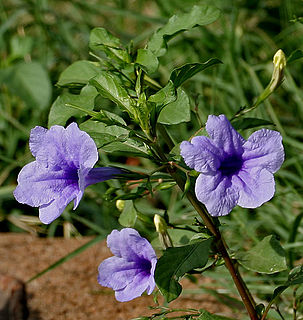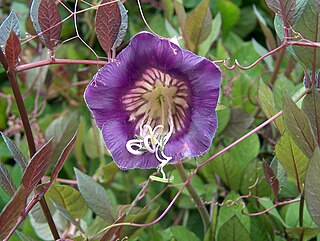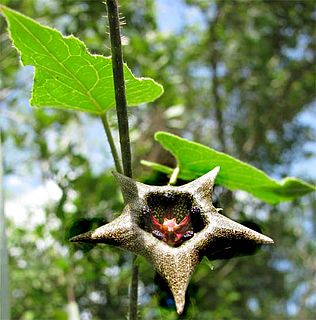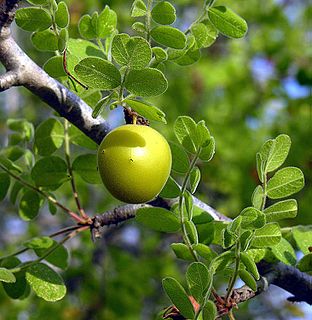
Bauhinia is a large genus of flowering plants in the subfamily Cercidoideae and tribe Bauhinieae, in the large flowering plant family Fabaceae, with a pantropical distribution. The genus was named after the Bauhin brothers Gaspard and Johann, Swiss-French botanists.

Ageratum is a genus of 40 to 60 tropical and warm temperate flowering annuals and perennials from the family Asteraceae, tribe Eupatorieae. Most species are native to Central America and Mexico but four are native to the United States.

Sterculia is a genus of flowering plants in the mallow family, Malvaceae: subfamily Sterculioideae. Members of the genus are colloquially known as tropical chestnuts. The scientific name is taken from Sterculius of Roman mythology, who was the god of manure; this is in reference to the unpleasant aroma of the flowers of this genus. Sterculia may be monoecious or dioecious, and flowers unisexual or bisexual.

Bignonia is a genus of flowering plants in the family Bignoniaceae. Its genus and family were named after Jean-Paul Bignon by his protégé Joseph Pitton de Tournefort in 1694, and the genus was established as part of modern botanical nomenclature in 1753 by Carl Linnaeus. Species have been recorded from the southern USA, Central to most of South America.

Ruellia is a genus of flowering plants commonly known as ruellias or wild petunias. They are not closely related to petunias (Petunia) although both genera belong to the same euasterid clade. The genus was named in honor of Jean Ruelle, herbalist and physician to Francis I of France and translator of several works of Dioscorides.

Sideroxylon is a genus of trees in the family Sapotaceae described as a genus by Linnaeus in 1753. They are collectively known as bully trees. The generic name is derived from the Greek words σιδηρος (sideros), meaning "iron", and ξύλον (xylon), meaning "wood."

Dalea is a genus of flowering plants in the legume family, Fabaceae. Members of the genus are commonly known as prairie clover or indigo bush. Its name honors English apothecary Samuel Dale (1659–1739). They are native to the New World, where they are distributed from Canada to Argentina. Nearly half of the known species are endemic to Mexico. Two species of Dalea have been considered for rangeland restoration.

Alseis is a genus of flowering plants in the family Rubiaceae. It was described by Heinrich Wilhelm Schott in 1827. The genus is native to tropical Latin America from southern Mexico to Brazil.

Arachnothryx is a genus of flowering plants in the family Rubiaceae. It contains about 107 species. It is found from Mexico to Peru and in Trinidad.

Acleisanthes is a genus of flowering plants in the Bougainvillea family, Nyctaginaceae. There are currently 16 species. The generic name is derived from the Greek words ακλειοτος (akleistos), meaning "not closed", and ανθος (anthos), meaning "flower". Plants of this genus are known commonly as trumpets due to the elongated, open-ended shape of their flowers. These are arid-adapted perennials with thick taproots which are usually compact and low to the ground or slightly ascending. An individual plant may have cleistogamous flowers as well as opening flowers which are usually nocturnal as a water-saving adaptation and are pollinated by night-flying or crepuscular insects such as hawkmoths. Flowers are usually white, sometimes yellow. These plants are native to the Chihuahuan and Sonoran Deserts of Mexico and the United States.
Psacaliopsis is a genus of Mexican plants in the groundsel tribe within the daisy family.

Cobaea is a genus of flowering plants including about 20 species of rapid growing, ornamental climbers native to Mexico. The botanical name honors Father Bernabé Cobo, Spanish Jesuit of the seventeenth century, naturalist, and resident of America for many years. The woody stems can reach 20 ft (6 m). Leaves are alternate lobed with opposite pairs and tendrils. In late summer to early spring, the large, bell-shaped flowers are borne profusely and singly along the stems with bright green, violet, or purple in colors. The plants can become invasive in some areas, and are common weeds in New Zealand.

Deppea is a genus of flowering plants in the family Rubiaceae. The genus is found in Mexico, Central America and from Brazil to northeastern Argentina.
Elaeagia is a genus of flowering plants in the family Rubiaceae. The genus is found from Mexico to tropical America.

Dictyanthus is a genus of plant in family Apocynaceae, first described as a genus in 1844. It is native to Mexico and Central America

Drimycarpus is a small genus of trees in the cashew and sumac family Anacardiaceae. The generic name is from the Greek meaning "pungent fruit".

Holigarna is a genus of trees in the subfamily Anacardioideae of the cashew and sumac family Anacardiaceae. They grow naturally in India, Bangladesh and Indo-China. This is a poisonous tree if contacted it would irritate skin chemically and result in irreversible skin damage. Smoke from burning this wood is dangerously disabling.
Orthopterygium is a monotypic genus of dioecious plants in the subfamily Anacardioideae of the cashew and sumac family Anacardiaceae. It contains the single species Orthopterygium huaucui, which is endemic to western Peru.

Cyrtocarpa is a genus of trees in the subfamily Spondiadoideae of the cashew and sumac family Anacardiaceae. Their habitat is dry forests to open arid areas. They grow naturally in Mexico and northern South America.
















